Abstract
The paper aims to analyze the factors affecting the parameters of surge protection devices with a spark gap and assess the impact of changing these parameters on the level of overhead line strength. For this purpose, this paper contains the results of tests that show the assessment of the impact of changing the spark gap parameters on the voltage–time characteristics of selected protection devices in the range of negative and positive polarity. The paper presents how the change in the parameters of the component element of the surge protection device, which is the spark gap, may affect the selection of the line surge protection method. In addition, the paper presents a method of assessing the strength of an overhead line, taking into account the case of installing surge protection devices at the insulators. The implementation of these tests supports further activities aimed at the actual values of parameters affecting the strength of overhead lines.
1. Introduction
Power grids play an important role in the development of the economy. Ensuring reliable and trouble-free operation and development of these grids based on a precise assessment of threats is the task of the power grid operator/distributor [1,2]. One of the significant threats resulting in interruptions in the power supply to consumers is lightning activity [3,4]. Therefore, ensuring effective surge protection with appropriate parameters adapted to the overhead line on which such protection will be installed is a priority objective [5,6,7].
Therefore, this paper will present the results of research on the analysis of factors affecting the parameters of selected surge protection devices and the impact of these parameters on the assessment of the strength of the overhead line in a medium-voltage grid. Medium-voltage grids are grids above 1 kV. In most countries, the series of rated voltages of this type of grid consists of 6 kV, 10 kV, 15 kV, 20 kV, 30 kV, 35 kV, and others. Depending on the rated voltage, some types of medium-voltage grids may perform a specific function (supply of an industrial facility) or are widespread in a certain area to supply facilities of a specific type/purpose (mines). Most often, the above characteristics may apply to the 6 kV grid. In addition, medium-voltage networks for individually rated voltages have some design peculiarities, which may also result from the location of individual lines [8,9]. With the increase in the rated voltage, the distance between the phases increases, i.e., the dimensions of the pole increase. Moreover, in the case of networks with a rated voltage of 35 kV, pole structures can be made even in the dimensions of high-voltage networks (110 kV). Such lines may also require a different approach to overvoltage protection [9,10]. For example, the use of a lightning conductor increases the load on the pole and accordingly increases its dimensions. In addition, in the case of phase conductors in medium-voltage grids, conductors of various constructions/types can be used: bare, partially insulated, and fully insulated conductors. Insulated wires weigh more, so they also lead to a greater load on the poles and increase the overall dimensions of the pole structure. If bare wires do not require protection against overvoltages due to the inability for overvoltages to damage them, then in the case of insulated wires, such protection must be mandatory.
Considering the above, it can be concluded that the location of the line, the category of the receivers, and the design peculiarities of the line are important for the selection of the method of overvoltage protection of power grids. Determining the parameters of the expected atmospheric surges is important in the context of the selection of surge protection devices [11,12]. There are also different methods to coordinate overhead line insulation and surge protection devices [13,14]. Medium-voltage networks are very sensitive to atmospheric overvoltages [15]. This is due to their low strength, which is determined by the appropriate design features and the strength level of the insulators installed on the line poles [9]. Therefore, to determine the need for surge protection and their method of implementation, the following steps have been proposed:
- Determining the construction and electrical parameters of the line (rated voltage, type of poles, phase conductors, etc.): the implementation of this step will allow one to decide on the need for surge protection;
- Determining the location of the line or its selected fragments for which surge protection should be provided: the implementation of this step will make it possible to determine the fragments that need to be protected against overvoltages and what types of overvoltages (induced or direct lightning strike) affect selected line sections;
- Determining the method of overvoltage protection on selected fragments or the entire line: the implementation of this step will enable the selection of a surge protection device or a ground wire, taking into account the data from previous steps in order to ensure effective protection of the overhead line against overvoltages.
Therefore, this paper will consider:
- The method of determining the parameters of the surge protection device affecting the effectiveness of the surge protection of the medium-voltage overhead line;
- The impact of the 50% surge voltage parameter of the surge protection device on the assessment of the line’s strength.
In this paper, in the first chapter, the specificity of the networks of different voltages and their overvoltage protection were considered. Section 2 shows the methods of determining the parameters of the surge protection device with a spark gap that affect the effectiveness of the overvoltage protection of the overhead line. Section 3 compares the 50% surge voltage of the surge protection device for different options depending on the parameters of the spark gap component of these devices. Section 4 analyzes the impact of the 50% surge voltage of the surge protection device on the assessment of the strength of the power grid. Section 5 presents a short summary and conclusions from the conducted research.
2. Materials and Methodology
This article considers a medium voltage overhead line that requires the use of surge protection devices. As possible devices for use, a long flashover arrester (LFA) and a multi-chamber insulator arrester (MCA) were considered, which actually bypass the insulator and replace it in the line for the analysis of overvoltage processes taking place in this line. The devices also have a spark gap, the parameters of which will be analyzed in detail in this paper. Parameters and information about these devices are included in [16,17].
For this purpose, measurements were made in laboratory conditions using a four-stage generator, enabling the application of a standard lightning voltage impulse of the shape of 1.2/50 mks to the device. The tests were performed using the top-down method according to [18]. For the LFA, the tests were carried out at a temperature of 21.1 °C, atmospheric pressure of 98.93 kPa, and humidity of 36.6%. For the MCA, the tests were carried out at a temperature of 23 °C, atmospheric pressure of 99.86 kPa, and humidity of 43%.
This made it possible to develop the voltage–time characteristics of these devices for various installation options on the pole. The range of options include various lengths of the spark gap between the phase conductor and the surge protection device in question and are as follows: 20, 30, and 40 mm. In the tests, measurements were made for positive and negative polarity. The obtained results were compared with the voltage–time characteristics of the medium-voltage insulator in order to perform further analysis on the impact of the parameters of the surge protection device on the strength of the overhead line.
If a device is used to protect the line against overvoltages, it is necessary to consider the parameters of this overvoltage protection device during the calculations related to the line strength assessment. This is due to the fact that in such a situation, the device in question actually replaces the insulator when assessing the strength of the line. Bearing in mind that in order to effectively discharge the overvoltage to the ground, the voltage–time characteristic of the device must be below the characteristic of the insulator, and the 50% surge voltage of this surge protection device must be lower than the 50% surge voltage of the insulator. Therefore, in the case of evaluating the line strength based on the parameters of the surge protection device, they will be different compared to the results based on the insulator parameter. However, these results will reflect the actual state after the installation of surge protection devices. At the same time, depending on the type of surge protection device, it is necessary to specify the conditions for which the 50% surge voltage parameter of this device should be taken into account in the assessment of the line strength.
3. Results
As can be seen from the test results, with the increase in the spark gap between the surge protection device and the phase conductor, the voltage–time characteristic becomes higher and higher (Figure 1 and Figure 2).
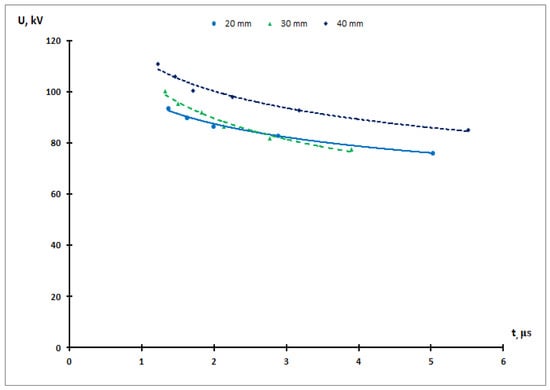
Figure 1.
Voltage–time characteristics of the MCA for different spark gap lengths in the case of positive polarity.
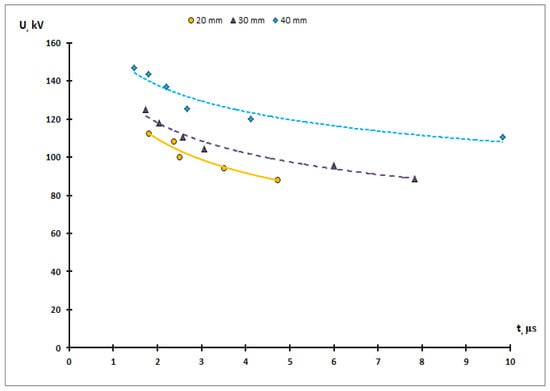
Figure 2.
Voltage–time characteristics of the MCA for different spark gap lengths in the case of negative polarity.
For the voltage–time characteristics of the MCA, the difference between the extreme options (20 and 40 mm) is approx. 17 kV, i.e., approx. 17%, in the case of positive polarity (Figure 1) and approx. 24 kV, i.e., approx. 19%, in the case of negative polarity (Figure 2). In the case of the LFA, the difference is about 45 kV, or about 51%, in the case of positive polarity (Figure 3) and about 30 kV, or about 21%, in the case of negative polarity (Figure 4).
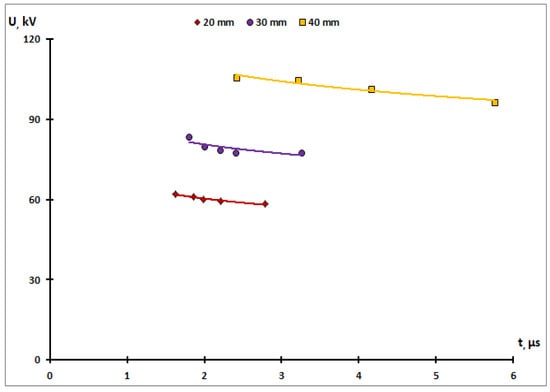
Figure 3.
Voltage–time characteristics of the LFA for different spark gap lengths in the case of positive polarity.
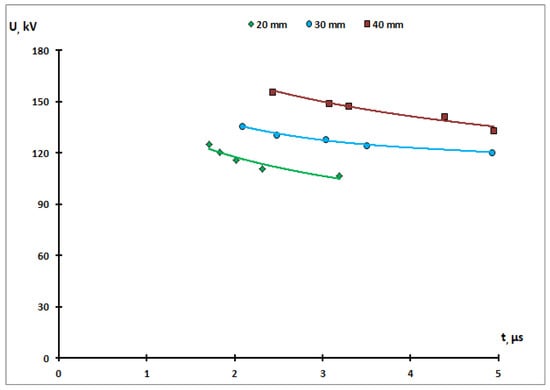
Figure 4.
Voltage–time characteristics of the LFA for different spark gap lengths in the case of negative polarity.
As can be seen, the change in the length of the spark gap affects the voltage–time characteristics of the surge protection devices in a different way. The greatest influence is seen in the case of the LFA with a positive polarity. In the case of the MCA, changing the spark gap length does not cause much difference between the positive and negative polarities.
In the case of the operation of surge protection devices, it is sometimes problematic to maintain a specific value of the spark gap length. Therefore, the best solution is to take into account the longest possible spark gap during the analysis of the surge protection device, which may increase during operation, even due to climatic and terrain conditions (storm, tree branches, etc.). At the same time, taking into account such an extreme case, it is necessary to consider how it may affect the assessment of line strength and by what parameter the voltage–time characteristics of the surge protection devices can be mapped in order to perform such an analysis. For this purpose, in the next chapter, to assess the strength of the line, the impact of different values of 50% of the surge voltage on the strength of a standard high-voltage overhead line was analyzed.
However, in order to select the values of the 50% surge voltage, which can be characterized by a standard high-voltage overhead line, a comparison was made between the largest and smallest values of the voltage–time characteristics of the considered surge protection devices (LFA and MCA) and the standard medium-voltage insulator according to the data contained in [19] and as shown in Figure 5 and Figure 6.
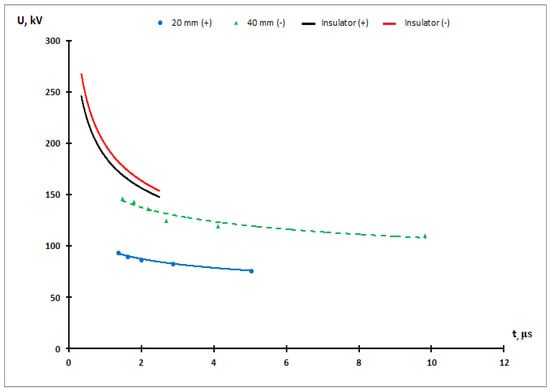
Figure 5.
Extreme cases of MCA voltage–time characteristics in terms of the maximum and minimum value of the analyzed spark gap lengths and voltage–time characteristics of a standard medium-voltage insulator for positive and negative polarity.
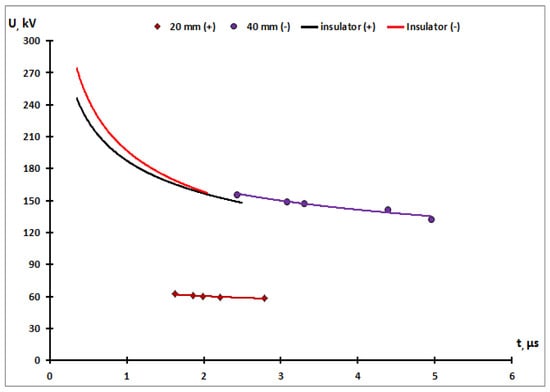
Figure 6.
Extreme cases of LFA voltage–time characteristics in terms of the maximum and minimum value of the analyzed spark gap lengths and voltage–time characteristics of a standard medium-voltage insulator for positive and negative polarities.
The greatest differentiation between the voltage–time characteristics of the LFA and MCA occurs in the case of a spark gap length of 20 mm for positive polarity and 40 mm for negative polarity. The graphs in Figure 5 and Figure 6 show the voltage–time characteristics of a standard medium-voltage insulator for the two polarities. The above extreme cases are considered in the next chapter in the context of overhead line strength assessment.
4. Discussion
Taking into account the standard method of evaluating the strength of medium-voltage lines proposed by [15] and the information from the previous chapter, it was assumed that the considered cases of changes in the parameters of surge protection devices would be represented in these calculations by the 50% LFA and MCA surge voltages. In the case of determining the number of line outages caused by the influence of atmospheric overvoltages, such a parameter is included, among others, in the following formulas calculating the value of induced overvoltages causing flashovers (second and third phases (1) and (2)):
where , according to [20], is assumed to be a 50% impulse voltage of the line insulation (in the case of a standard medium-voltage overhead line, the value for positive polarity is 140 kV and for negative polarity, 150 kV), while in the context of the tests presented in this article, this parameter will take into account the 50% surge voltage of positive polarity for the LFA and MCA with a spark gap length of 20 mm and negative polarity for the LFA and MCA with a spark gap length of 40 mm.
Other parameters are as follows: —wave impedance of the phase conductor on which the flashover took place; —grounding resistance of the tower; and , —coefficients taking into account the mutual wave impedances of the three phases. Calculations were made based on a standard medium-voltage line with a fixed span length of 70 m, pole height of 12 m, and overhangs of 1 m. The results of the calculations are shown in Figure 7.
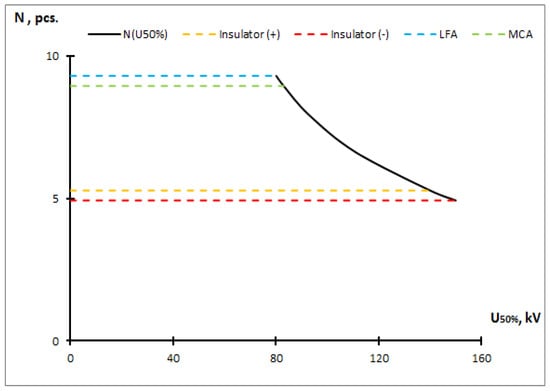
Figure 7.
The dependence of the number of shutdowns of a standard overhead line on the change in the 50% insulation surge voltage for positive and negative polarities and the number of line shutdowns on the transformation of 50% surge voltage for MCA and LFA in the case of a spark gap length of 20 mm with positive polarity.
As can be seen from Figure 7, with an increase of 50% in the surge voltage of the surge protection devices, the expected strength of an example medium-voltage overhead line increases, and the number of line outages as a result of the impact of atmospheric overvoltages decreases. In addition, Figure 7 shows that the line strength, taking into account a 50% increase in the surge protection device’s surge voltage, is almost twice as low (by approximately four strokes) than in the case with the same parameter for the insulator. Therefore, after analyzing the strength of the line through the calculations made in this article, it was proposed to include the case that causes the most significant number of line outages in the measures. Considering the above, when installing surge protection devices in the line, it was proposed to consider the 50% surge voltage of the surge protection device instead of the insulator for the option with a spark gap length of 20 mm an a positive polarity. Such an approach will make it possible to consider possible unfavorable conditions causing interruptions in operation or damage to equipment that may occur during the operation of the overhead lines. In addition, the above proposal will make it possible to map the actual strength level of the line because the insulator overestimated this strength. However, there are other parameters that affect the number of line activations and which are taken under certain assumptions. Therefore, the direction of further research must be to specify the method of assessing the strength of the overhead line based on the largest possible number of parameters that reflect the actual conditions of the line. The publication was funded in whole or in part by the Warsaw University of Technology.
5. Conclusions
This paper analyzes the impact of changing the spark gap parameters on the durability of surge protection devices and the effect of selected parameters of surge protection devices on assessing the strength of overhead lines in the example of a medium-voltage power grid. The following results were achieved:
- The voltage–time characteristics for different lengths of the LFA and MCA spark gaps were developed. The characteristics show that a change in the parameters of the spark gap translates into a change in the durability of the surge protection devices under consideration. In addition, changing the spark gap parameters has a greater effect on the LFA than on the MCA.
- The impact of the MCA and LFA spark gap lengths were compared in relation to positive and negative polarities. The comparison shows that changing the parameters of the spark gap for different polarities has similar effects in the case of MCA and amounts to approx. 17–19%, depending on the length of the spark gap. For the LFA, the situation is different. A greater effect of changing the spark gap length is visible for a positive polarity (approx. 50%), while for a negative polarity, the effect of changing the spark gap length is similar to that observed in the case of the MCA.
- A comparative analysis was conducted by considering the 50% surge voltage parameter of selected surge protection devices instead of an insulator in the assessment of an overhead line’s durability in the example of a standard medium-voltage overhead line. As a result of the analysis, it was found that for the case of calculations taking into account the 50% the surge voltage of the insulators, the number of outages of the overhead line is almost two times lower than it was for the selected surge protection devices.
- It was proposed to include the 50% the surge voltage of a specific type of surge protection device with a spark gap length of 20 mm and a positive polarity, which makes the calculations consider a more significant number of unfavorable conditions that may occur during line operation.
The proposal to clarify the assessment of line strength contained in this paper will enable the implementation of further research aimed at mapping the actual (and not assumed) value of as many parameters as possible that affect the total line strength.
Funding
This research was funded in whole or in part by the National Science Centre, Poland, allocated on the basis of the decision no. DEC-2022/06/X/ST7/00228. For the purpose of Open Access, the author has applied a CC-BY public copyright license to any Author Accepted Manuscript (AAM) version arising from this submission.
Conflicts of Interest
The author declare no conflict of interest.
References and Notes
- Hoduń, P.; Borecki, M. Reliability assessment of MV power connections. Energies 2021, 14, 6965. [Google Scholar] [CrossRef]
- Borecki, M.; Sobolewski, K. An elimination method for an emergency situation in Gas-insulated switchgear in power grids. IEEE Trans. Power Deliv. 2021, 36, 3724–3732. [Google Scholar] [CrossRef]
- Borghetti, A.; Napolitano, F.; Nucci, C.A.; Paolone, M. Effects of nearby buildings on lightning induced voltages on overhead power distribution lines. Electr. Power Syst. Res. 2013, 94, 38–45. [Google Scholar] [CrossRef]
- Borghetti, A.; Napolitano, F.; Nucci, C.A.; Tossani, F. Response of distribution networks to direct and indirect lightning: Influence of surge arresters location, flashover occurrence and environmental shielding. Electr. Power Syst. Res. 2017, 153, 73–81. [Google Scholar] [CrossRef]
- Andreotti, A.; Pierno, A.; Rakov, V.A. An analytical approach to calculation of lightning induced voltages on overhead lines in case of lossy ground—Part I: Model development. IEEE Trans. Power Deliv. 2013, 28, 1213–1223. [Google Scholar] [CrossRef]
- Coelho, V.L.; Raizer, A.; Paulino, J.O.S. Analysis of the lightning performance of overhead distribution lines. IEEE Trans. Power Deliv. 2010, 25, 1706–1712. [Google Scholar] [CrossRef]
- Brignone, M.; Mestriner, D.; Procopio, R.; Piantini, A.; Rachidi, F. Evaluation of the mitigation effect of the shield wires on lightning induced overvoltages in MV distribution systems using statistical analysis. IEEE Trans. Electromagn. Compat. 2017, 60, 1400–1408. [Google Scholar] [CrossRef]
- Tossani, F.; Napolitano, F.; Borghetti, A.; Nucci, C.A.; Piantini, A.; Kim, Y.S.; Choi, S.K. Influence of the presence of grounded wires on the lightning performance of a medium-voltage line. Electr. Power Syst. Res. 2021, 196, 107206. [Google Scholar] [CrossRef]
- Borecki, M.; Ciuba, M.; Kharchenko, Y.; Khanas, Y. Main aspects influencing the evaluation of atmospheric overvoltages in high-voltage networks. Bull. Pol. Acad. Sci. Tech. Sci. 2021, 69, e135838. [Google Scholar]
- Mahmood, F.; Rizk, M.E.; Lehtonen, M. Risk-based insulation coordination studies for protection of medium-voltage overhead lines against lightning-induced overvoltages. Electr. Eng. 2019, 101, 311–320. [Google Scholar] [CrossRef]
- Mikropoulos, P.N.; Tsovilis, T.E. Statistical method for the evaluation of the lightning performance of overhead distribution lines. IEEE Trans. Dielectr. Electr. Insul. 2013, 20, 202–211. [Google Scholar] [CrossRef]
- Rizk, M.E.; Mahmood, F.; Lehtonen, M.; Badran, E.A.; Abdel-Rahman, M.H. Computation of peak lightning-induced voltages due to the typical first and subsequent strokes considering high ground resistivity. IEEE Trans. Power Deliv. 2016, 32, 1861–1871. [Google Scholar] [CrossRef]
- Mahmood, F.; Sabiha, N.A.; Lehtonen, M. Effect of combined AC and lightning-induced overvoltages on the risk of MV insulator flashovers above lossy ground. Electr. Power Syst. Res. 2015, 127, 101–108. [Google Scholar] [CrossRef]
- Bullich-Massague, E.; Sumper, A.; Villafafila-Robles, R.; Rull-Duran, J. Optimization of surge arrester locations in overhead distribution networks. IEEE Trans. Power Deliv. 2014, 30, 674–683. [Google Scholar] [CrossRef]
- Lehtonen, M. Fault rates of different types of medium voltage power lines in different environments. In Proceedings of the 2010 Electric Power Quality and Supply Reliability Conference, IEEE, Kuressaare, Estonia, 16–18 June 2010; pp. 197–202. [Google Scholar]
- Borecki, M.; Ciuba, M. Testing of Selected Surge Protection Devices in the Context of the Possibility of Ensuring the Reliability of Power Grids. Energies 2023, 16, 1445. [Google Scholar] [CrossRef]
- Borecki, M.; Kharchenko, Y. Comparative Simulation Analysis of Selected Medium and High Voltage Surge Protection Devices. Energies 2022, 15, 4326. [Google Scholar] [CrossRef]
- Maksymiuk, J.; Wohlmuth, F. Metody statystyczne w inżynierii elektrotechnicznej. In Wydawnictwa Politechniki Warszawskiej; Sekretarz Generalny SEP: Warszawa, Poland, 1981. [Google Scholar]
- Khalilov, F.H.; Evdokunin, G.A.; Polyakov, V.S.; Podporkin, G.V.; Tajibaev, A.I. Protection of Networks 6–35 kV from Surges; Energoatomizdat: Moscow, Russia, 2002. [Google Scholar]
- Larionov, V.P.; Aronov, M.A. Lightning protection in the electric power industry. M. Znamia. 1999; p. 48. [Google Scholar]
Disclaimer/Publisher’s Note: The statements, opinions and data contained in all publications are solely those of the individual author(s) and contributor(s) and not of MDPI and/or the editor(s). MDPI and/or the editor(s) disclaim responsibility for any injury to people or property resulting from any ideas, methods, instructions or products referred to in the content. |
© 2023 by the author. Licensee MDPI, Basel, Switzerland. This article is an open access article distributed under the terms and conditions of the Creative Commons Attribution (CC BY) license (https://creativecommons.org/licenses/by/4.0/).